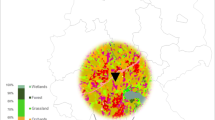Abstract
A method for assessing the risk for honeybees from pesticide exposure via pollen is proposed. Four pesticides, selected as markers, were monitored in pollen samples collected in two sampling areas, one located in an intensive agricultural area and the other far from direct pesticide impact. Analytical results were consistent with use patterns of the chemicals and their physico-chemical and persistence properties. For a preliminary estimate of bee exposure via pollen, both by ingestion and by contact, an exposure index was developed, based on physico-chemical properties, persistence and application rates. On the basis of the exposure estimates and acute toxicological data (ingestion and contact LD50), Toxicity Exposure Ratios (TERs) were calculated as indicators of the risk for honeybees due to this particular exposure route. TER values were compared to Hazard Quotient (HQ), calculated as the ratio between application rate and the LC50 value, according to European guidelines, showing a satisfactory agreement. The advantage of the above described procedures is that the environmental fate of the chemicals, and not only application rates, are taken into account. This approach may represent a preliminary tool for a comparative screening of the risk for pollinator insects due to this particular exposure route.
Similar content being viewed by others
References
Contessi, A. (1983). Le api: biologia, allevamento, prodotti. Bologna, Edagricole.
EC (1999). Règlement CE n° 1257/1999 du Conseil du 17 mai 1999 concernant le soutien au développement rural par le Fonds européen d'orientation et de garantie agricole (FEOGA) et modifiant et abrogeant certains règlements. G.U. n. L 160/80.
EEC (1991). Directive 91/414 CEE of 15 July 1991 (G.U. CEE n° L230 19 August 1991).
European and Mediterranean Plant Protection Organisation. (1993). Decision-making scheme for the environmental risk assessment of plant protection products. Bulletin OEPP/EPPO/ (23), 1–157.
Finizio, A. (1998). Definizione di criteri di classificazione del rischio ambientale di prodotti fitosanitari, con particolare riferimento agli effetti su organismi non bersaglio (parte II). Rapporto ANPA N.ro 97–58–RC050–75.
Paterson, S., Mackay, D., Bacci, E. and Calamari, D. (1991). Correlation of the equilibrium and kinetics of leaf-air exchange of hydrophobic organic chemicals. Environ. Sci. Technol. 25(5), 866–71.
Pinzauti, M., Frediani, D., Biondi, C., Belli, R., Panizzi, L., Cosimi, C. and Zummo, V. (1991). Uses of honeybees for monitoring environmental pollution (in Italian). Analysis 8, 355–405.
Russel, D., Meyer, R. and Bukowski, J. (1998). Potential impact of microencapsulated pesticides on New Jersey apiaries. American Bee J. 138(3), 207–10.
Seeley, T.D. (1985). Food collection. In J.R. Krebs and T. Clutton-Block (eds) Honeybee Ecology. A Study of Adaptation in Social Life, pp. 80–9. Princeton, NJ: Princeton University Press.
Seeley, T.D. (1995). The Wisdom of the Hive: The Social Physiology of Honeybee Colonies. Harvard University Press.
Thompson, H.M. and Hunt, L.V. (1999). Extrapolating from honeybees to bumblebees in pesticides risk assessment. Ecotoxicology 8(3), 147–66.
Tomlin, C.D.S. (1997). The Pesticide Manual: A World Compendium. (7a ed.) British Crop Protection Council (eds) Farnham, UK.
Wittman, D. and Engels, W. (1981). Development of test procedure for insecticide-induced brood damage in honey bees (in German). Mitteilungen der Deutschen Gellschaft fur Allgemine und Angewandte Entomologie 3, 187–90.
Author information
Authors and Affiliations
Rights and permissions
About this article
Cite this article
Villa, S., Vighi, M., Finizio, A. et al. Risk Assessment for Honeybees from Pesticide-Exposed Pollen. Ecotoxicology 9, 287–297 (2000). https://doi.org/10.1023/A:1026522112328
Issue Date:
DOI: https://doi.org/10.1023/A:1026522112328



